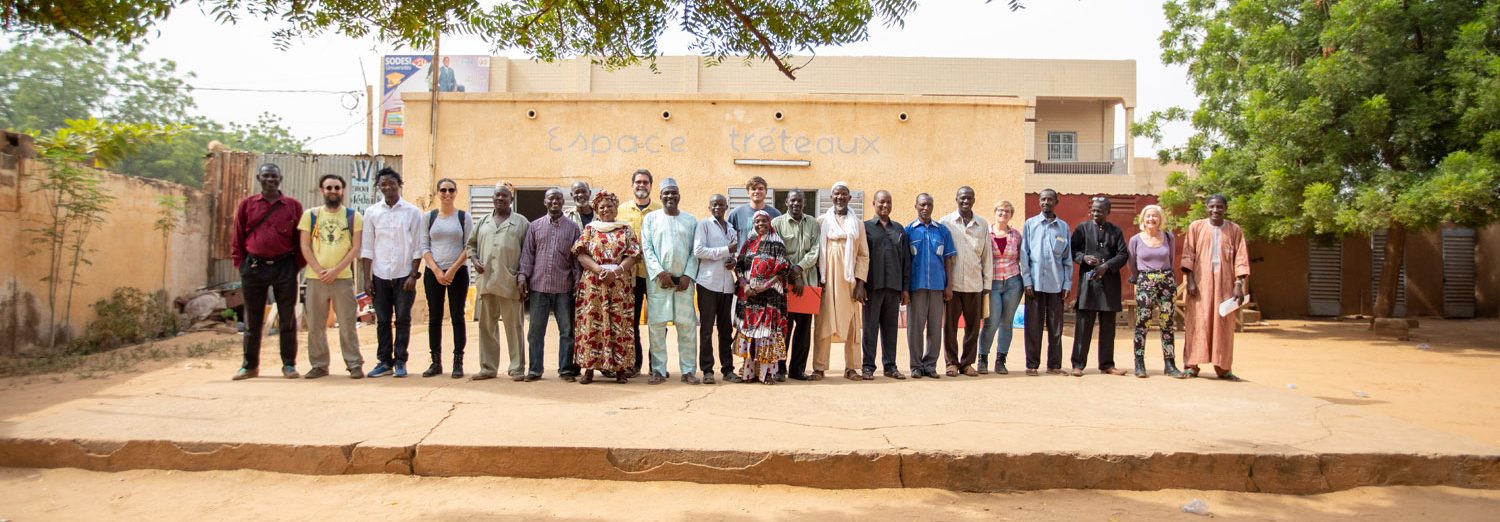Project History/Description
Du Quotidien + Salt, Water, Millet
U.S. Embassy, Niamey, Niger, 2017 – 2021

Artist Association Niamey, Niger, 2018, photo Max Hirchfeld
In January of 2017, Western Carolina University entered a partnership with Art in Embassies (AIE) to create commissioned artwork for the U.S. Embassy in Niamey, Niger. From the start, the project was structured within a collaborative university course, “Public Practice”, created by Tom Ashcraft, Distinguished Professor, MFA Director, School of Art + Design, Western Carolina University, Cullowhee, North Carolina (WCU). Over the project timeline, an evolving team of undergraduate and graduate art students worked with Ashcraft, faculty leadership, visiting artists, designers, and scholars to participate in the entire commissioning process. This engagement included concept research, design, development, presentation of proposal, overseeing fabrication, and final installation of the artwork on the grounds of the U.S. Embassy. Central to this project is a core meaning of diplomacy, the art of engaging with people in a sensitive and effective way. The root term of diplomacy is derived via French, from the ancient Greek, diploma. Diploma is composed of diplo, “folded in two,” and the suffix –ma, “an object.”
As lead AIE Curator, Sarah Tanguy explained: “Art is Embassies is pleased to partner with WCU on this important commission. Beyond the team’s creative problem solving, their underlying philosophy of global to local and their ethnographic approach will no doubt lead to work that is not only aesthetically and visually stimulating, but also one respectful of Niger’s history and reflective of the country’s present and future aspirations.”
In the fall of 2017, Ashcraft, along with WCU professor/colleague Morgan Kennedy, and Tanguy made an initial research trip to Niamey where they toured the new embassy building site; met Embassy staff and project managers, Niger’s cultural leadership, educators, students, and local artists; and visited key cultural sites. The goal was to begin connecting research to practice and to come away with “…a good sense of Niamey, to experience the city and its flow, grasp an idea of its significance historically, culturally, and environmentally, and to simply ask questions, shake hands and meet a range of people during our short visit.” (from Ashcraft’s travel notes). Based on this experience, (https://art.state.gov/western-carolina-university/), the “Public Practice” artist/project team began developing criteria for two commissions: Du Quotidien, a socially engaged photo-based artwork, for the interior gallery, and Salt Water, Millet, three sculptures created specifically for the embassy courtyard.
While the courtyard artwork, Salt, Water, Millet, shared a similar timeline to the interior commission in terms of concept development and studio research, it differed in approach. The WCU team knew the indoor piece (Du Quotidien) would be photo-based and was shaping into a socially engaged artwork. By contrast, the sculpture in the courtyard had to consider logistics, including the choice of materials, which needed to be resilient and specific to Niger and the Sahel, an ecoclimate zone of transition in Africa between the Sahara to the north and Savannas to the south. Travel to Niger and studio research had provided a wealth of information (ethnographic, geographic, strong visuals, etc.), and positioned the team in a good starting point for developing a preliminary concept.
Initially attention was drawn to water and eventually, the team drafted a large totem-like sculpture that would collect water into the embassy’s grey water system. Over time, the piece appeared overly complicated, and after a protracted construction delay, they concluded that this structure/sculpture was too “didactic” and did not possess the proper poetry for the space.
By fall 2019, Ashcraft recounts in his project notes: “…we have come up with a more thoughtful concept and sculptural proposal. We are now focusing on creating a grouping of three sculptures, each approximately four feet high, cast in bronze…” Each sculpture would be poetically and visually derived from elements vital to the region’s development and sustainability as well as to the human condition, locally (Sahel) and globally—salt, water and food. The driving images for these sculptural shapes were a salt pillar, and a wooden water well pully, and a bundle of millet.
Redirecting the courtyard project was a major and profound studio shift. More intimate, this grouping of three objects had a direct application to daily life, and simply felt like the right work to make for the space. Casting the sculpture in bronze, with a traditional green patina, was chosen for its durability, materiality, and site- responsive context. The finished works, now installed in the courtyard, are complemented by indigenous planting and seating, and together create an environment for conversation and contemplation.
Both artworks, Du Quotidien and Salt, Water, Millet are permanently installed in the US Embassy, Niamey, Niger.